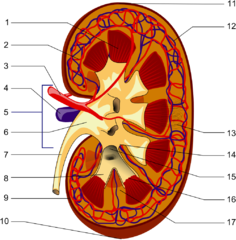|
UPDATED: Definition: "A hilum" is the area of an organ where all the structures that enter or leave the organ are found". The term is based on a Latin word meaning something small, or trivial. Also used to describe the small spot on a seed where the seed is attached. The Latin phrase [ne hilum] was used to denote something of no worth or "not at all". In English it would have been similar to "not worth a bean". The plural form for [hilum] is [hila].
In human anatomy the term is used more on the seed attachment meaning. Since a hilum is the area of an organ where all the structures that enter or leave the organ are found, severing the root structures at the level of the hilum detaches the organ from the body. There are several hila in the body:
• Renal hilum: The hilum of the kidney (see item 5 in the accompanying image)
• Lienal hilum: The hilum of the spleen
• Splenic hilum: The hilum of the spleen
• Pulmonary hilum: The hilum of the spleen
• Hepatic hilum: The hilum of the liver. This name is not commonly used and the hepatic hilum is known as the "porta hepatis" meaning the "door to the liver".
There is a wrong version of the term. The word [hilus] is sometimes used and is incorrect. This word was a mistake by the anatomist Bartolomeo Eustachius (c.1520 - 1574) that has continued until today.
Original Image by Piotr Micha? Jaworski; PioM EN DE PL (Own work) [GFDL (http://www.gnu.org/copyleft/fdl.html) or CC-BY-SA-3.0 (http://creativecommons.org/licenses/by-sa/3.0/)], via Wikimedia Commons
|
Longitudinal section of a kidney. 1-Renal pyramid, 3-Renal artery, 4-Renal vein, 5-Renal hilum, 6-Renal pelvis, 7- Ureter, 8-Minor calyx, 9-Renal capsule, 14-Minor calyx, 15- Major calyx, 16-Renal papilla, 17-Renal column .
|



